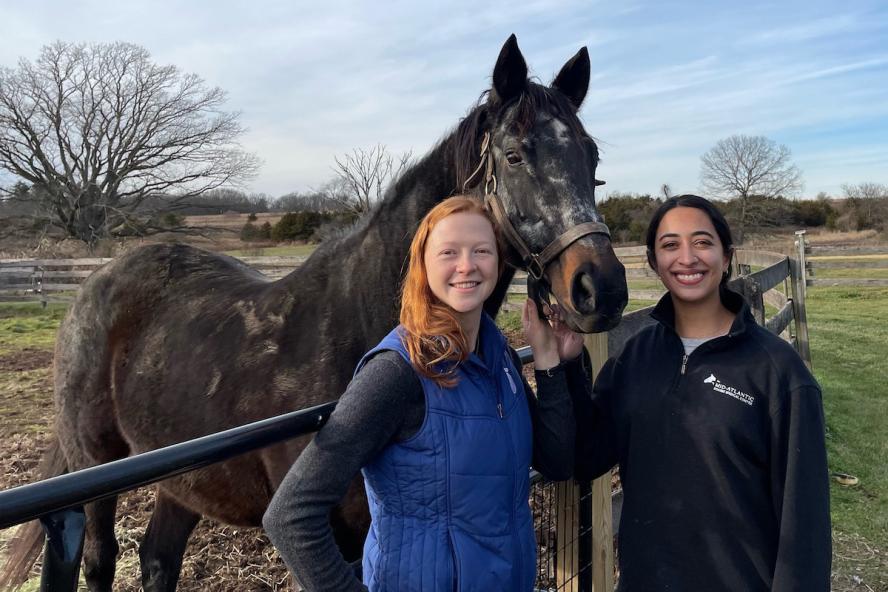-
About
- Leadership & Faculty
- News & Events
-
Academics
- Graduate
- Advanced Clinical Training
- Continuing Education
- Academic Offices
-
Student Life
-
Research
-
Hospitals & Clinics
- Emergency Care
- Hospital Services
-
Community Outreach
- Volunteer
Two of a Kind in Equine Medicine
Recent D.V.M. graduates share insights about their Mid-Atlantic Equine Medical Center internship

Two members of Cummings School’s Doctor of Veterinary Medicine Class of 2022 are interning at the Mid-Atlantic Equine Medical Center in Ringoes, New Jersey. We recently caught up with Lexi Fielding, V22 (she/her), and Ananya Mahalingham-Dhingra, V22 (she/her).
Why did you pursue an internship at the Mid-Atlantic Equine Medical Center?
Both graduates mentioned the influence of their Cummings School mentors, Dr. Amanda Prisk and [former Cummings School large animal medicine resident] Dr. Jillian Minuto, who had both gone to Mid-Atlantic for their internships prior to residency, and spoke about how well it had prepared them for their careers.
Fielding: When looking for internships, I wanted to go somewhere that had a high caseload, good mentorship, and a rotating schedule through equine medicine, surgery, anesthesia, and ambulatory services.
Mahalingham-Dhingra: As a busy private practice referral center, the hospital’s caseload ranges from backyard ponies to high level racehorses. Based on the recommendation from Drs. Prisk and Minuto, I knew I would gain excellent experience and have great mentorship during the internship year.
What aspect(s) of your Cummings School education and experience prepared you for the internship?
Mahalingham-Dhingra: As a student technician in the Hospital for Large Animals, I gained experience with a wide variety of cases in both medicine and surgery and practiced basic clinical skills, which were very helpful, especially as I began my internship. Additionally, I served as a research coordinator for multiple clinical trials focusing on equine asthma [with Dr. Melissa Mazan, V93] which provided hands-on skills and helped me to simultaneously juggle multiple cases.
Fielding: I was a student technician on the large animal technician team—and eventually as one of the coordinators—all four years at Cummings School. I gained many technical skills that I use every day. I participated in the Large Animal Emphasis Program during my clinical year, where I gained more time in the large animal hospital in exchange for some of the small animal specialty rotations. And I pursued extra rotations on large animal surgery, ultrasound, and anesthesia at our field service. I’m also grateful for the opportunity to travel to many clinics and gain experiences as an extern with the amount of elective time we had as clinical students.
What are your responsibilities as an intern?
Fielding: On each rotation, I coordinate the treatment plans for the inpatients alongside the senior clinicians on the service I am assigned to, and I am a primary caregiver along with our nurses and veterinary assistants for those patients. I am an assistant surgeon for our routine and emergent soft tissue and orthopedic procedures, and I perform the anesthesia for procedures when I’m on that rotation. On overnights, I take in emergencies and evaluate our dynamic inpatients to either follow or alter treatment plans as needed.
Mahalingham-Dhingra: It is a highly hands-on internship. We intake emergencies, ranging from lacerations to colics to neonates, perform inpatient and outpatient procedures, and scrub in and assist on a variety of elective and emergency surgeries. We also create treatment plans, do billing, and some client communication for all patients. Each day is different, and the experience I’ve gained so far here has been invaluable.
Are there any new areas of large animal medicine that you’ve experienced and enjoyed?
Mahalingham-Dhingra: The internship rotates through internal medicine, surgery (orthopedic and soft tissue), anesthesia, emergency and critical care, and field service. Although internal medicine is where my heart lies, I’ve really enjoyed my overnight rotations in emergency and critical care. My surgery rotations have also been enjoyable and helpful in rounding out my knowledge in other areas.
Fielding: We recently installed a new CT machine with the capability of performing imaging, both standing and under general anesthesia, including CT myelograms. I’m amazed at the information we can obtain with this technology, and I look forward to learning more about how we can use this imaging for surgical planning and guidance.
With which Cummings School faculty members have you stayed in contact?
Fielding: I recently reconnected with several members of the surgery team while attending the American College of Veterinary Surgeons conference in October, and I enjoyed catching up about Cummings School. I have also been in touch with Dr. Wade Tenney, whom I thank for helping me become confident in my ultrasound skills, which has been very helpful as an intern. I am currently working on two different publications, one with Dr. Carl Kirker-Head and one with Dr. Mazan as co-authors, and I am very thankful for their guidance.
Mahalingham-Dhingra: I have kept in close contact with a few faculty, particularly the internal medicine team at the Hospital for Large Animals. We have continued to work on a couple research projects and they have been very helpful in providing guidance for my future.
Upon completion of your internship, what’s next and what are your career aspirations?
Mahalingham-Dhingra hopes to pursue an internal medicine residency, possibly with a Ph.D. component, while Fielding is applying for a large animal surgical residency for next year and aims for a career that combines lameness, soft tissue, and emergency medicine with an opportunity to continue mentoring students.